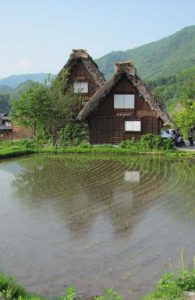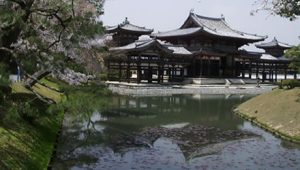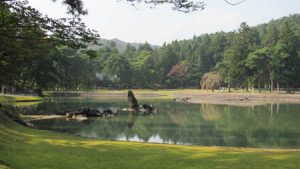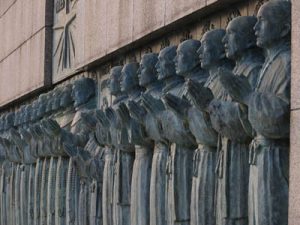World Heritage sites
Places that are ‘inscribed on the World Heritage List’ for Japan are listed below. Where relevant the page numbers in Japan by Rail are given.
All over Japan
Thirty three float festivals (as one item) were added to the UNESCO Intangible Cultural Heritage of Humanity list in December 2016; the festivals included are listed below.
The place name is included if not part of the festival’s name and is in bold and a page reference given if the festival and/or place is mentioned in Japan by Rail:
Hachinohe Sansha (p341); Kakunodate (pp338-9); Tsuchizaki Shinmei Shrine (Akita); Hanawa (Kazuno); Shinjo (p340 & p348); Hitachi Furyumono; Karasuyama Yamaage (Nasukarasuyama); Kanuma Imamiya Shrine Festival (Kanuma); Chichibu Night Festival; Kawagoe Hikawa (p322); Sawara Float (Katori); Takaoka Mikurimayama; Uozu Tatemon; Johana Hikiyama (p188); Seihaku (Nanao); Takayama (p222); Furukawa (Hida-Furukawa) (pp193-4; Ogaki; Owari Tsushima Tenno (Tsushima/Aisai); Chiryu; Inuyama (p207); Kemezaki Shiohi (Handa); Sunari (Kanie); Kujirabune (Yokkaichi); Ueno Tenjin (Iga); Ishidori (Kuwana); Nagahama Hikiyama (p236); Kyoto Gion – Yamahoko (p260); Hakata Gion Yamakasa (p435); Tobata Gion, Kitakyushu (pp406-9); Karatsu Kunchi; Yatsushiro Myoken; and Hita Gion.
Honshu
Central Honshu

(© Japan by Rail)
Cultural
- Historic villages of Shirakawa-go and Gokayama (see pp226-7 & pp233)
- Mt Fuji (Fuji-san), sacred place and source of artistic inspiration, (see pp140-3 & 175); the inscription actually includes 25 sites on and around Mt Fuji
- Tomioka Silk Mill and related sites (see p180) Tomioka City, Gunma Prefecture. Each of the four sites included in this inscription played a different role in the production of silk.
- The National Museum of Western Art, in Tokyo, (see p116) was added to UNESCO’s World Heritage list in July 2016 as part of the registration of The Architectural work of Le Corbusier, an outstanding contribution to Modern movement.
Natural
- Ogasawara Islands; also known as the Bonin Islands. These have a wide variety of flora and fauna and are in the Pacific Ocean about 1000km from Tokyo. They can only be reached by ferry (a 24hr journey).
On the tentative list
- Temples, shrines and other structures in ancient Kamakura (see pp136-40)
Kansai
Cultural

- Horyu-ji (see pp270-1), near Nara, and other Buddhist monuments in the area
- Historic monuments in ancient Kyoto (see pp249-57), Uji (Byodo-in; see p265) and Otsu
- Historic monuments in ancient Nara (see pp266-8)
- Sacred sites and pilgrimage routes in the Kii mountain range, Wakayama (see p242). The best-known site in this grouping is probably Koya-san; Danjo-Garan is one of the two most sacred sites in Koya-san.
On the tentative list
- Asuka-Fujiwara, near Nara, Kansai: archaeological sites of Japan’s ancient capitals and related properties
- Mozu-Furuichi Kofungun, ancient tumulus clusters
Western Honshu
Cultural
- Hiroshima Peace Memorial (Genbaku Dome; see pp303-4)

Itsukushima torii, Miyajima
(© Japan by Rail) - Himeji Castle (see p274)
- Itsukushima Shinto Shrine, Miyajima (see p309)
- Iwami Ginzan Silver Mine and its cultural landscape (see pp286-7)
- Sites of Japan’s Meiji Industrial Revolution: Iron and steel, shipbuilding and coal mining Yamaguchi and Kyushu
On the tentative list
- Hikone castle (see p236)
Tohoku
Cultural
- Shrines and temples in Nikko (see pp323-5)

Pure Land Garden, Motsu-ji, Hiraizumi
(© Japan by Rail) - Hiraizumi: temples, gardens and archaeological sites representing the Buddhist Pure Land (see pp334-5)
Natural
Shirakami-Sanchi
An area in the mountains of northern Honshu which contains the last virgin remains of the cool-temperate forest of Sibold’s beech trees; the trees used to cover the hills and mountains all over northern Honshu.
Cultural
- Jomon archaeological sites in northern Tohoku (p362), Hokkaido and other regions
On the tentative list
- Hiraizumi: temples, gardens and archaeological sites representing the Buddhist Pure Land (extension to the area already inscribed; see above)
- The Sado complex of heritage mines, primarily gold mines
Hokkaido
Natural
- Shiretoko (see p378)
Kyushu

(© KU)
Cultural
- Sites of Japan’s Meiji Industrial Revolution: Iron and steel, shipbuilding and coal mining Kyushu (p441) and Yamaguchi
- Hidden Christian sites in the Nagasaki region (see pp440)
Natural
- Yakushima, Osumu Islands, nr Kagoshima, Kyushu
- Okinoshima Island and related sites in Munakata rigion
Okinawa
Cultural
- Gusuku sites and related properties of the kingdom of Ryukyu
-
Anami-Oshima Island, Tokunoshima Island, Northern part of Okinawa Iland and Iriomote Island
